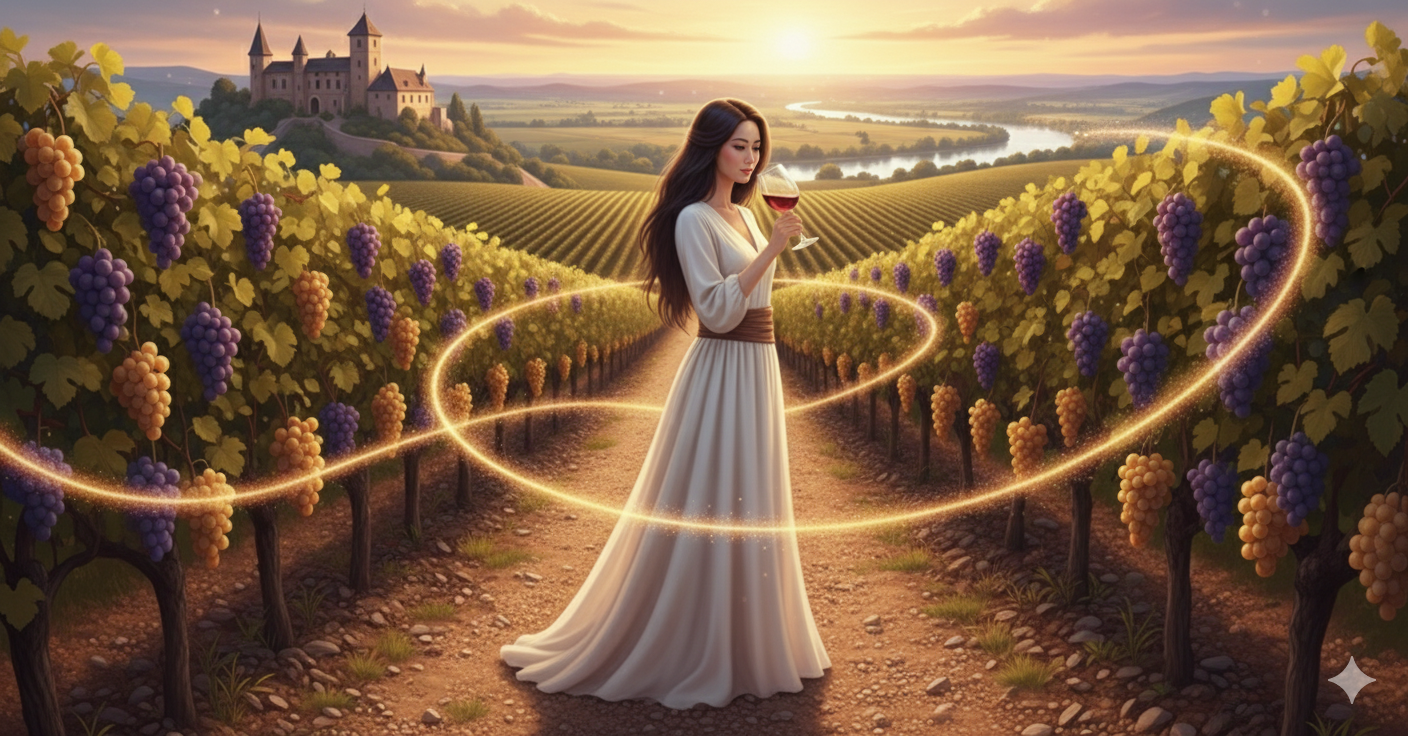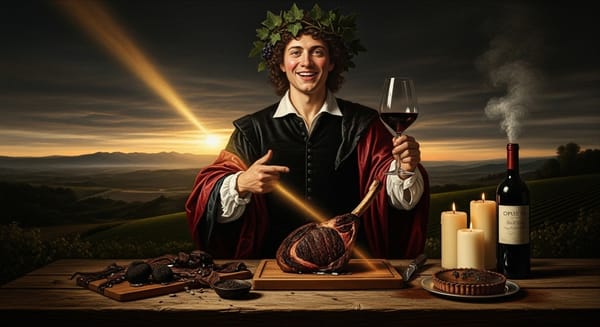The Memory of Smoke and Earth: A Chronicle of Graves
Graves/Pessac-Léognan is Bordeaux's birthplace, known for exceptional red Bordeaux blend wines and world-class dry white Bordeaux. The distinct gravel terroir and proximity to the Garonne River yield complex, smoky, and age-worthy wines.

The mortal world often mistakes stillness for peace. I know better. True peace is a restless thing, a continuous flux—the slow, insistent turning of the tides, the inexorable creep of time’s shadow. It is this profound, ancient restlessness I find reflected in the wines of Graves, a place of profound antiquity on the Left Bank of Bordeaux. It is a region named simply for its soil, a stark descriptor that belies the soul it holds. Yet, within the modern appellation of Pessac-Léognan, carved from the northern, most storied part of Graves, a transformation has occurred. It is not an exile, but a deepening—a focus that separates the ephemeral joy from the enduring truth.
These wines don't roar with sun-drenched arrogance; they hum with the low-frequency thrum of history, a sound akin to a heart beating deep beneath the earth. They possess the melancholy grace of a half-forgotten dream—not sad, but layered with the poignant wisdom of things that have lived long and seen much. To taste them is to be invited into a dialogue with the past, to feel the cool, mineral-etched kiss of the Garonne River and the warm, lingering sigh of the ancient forests that once shadowed these fields. It is a subtle confession of vulnerability: that the most beautiful creations are always those closest to the crucible of the city, standing firm against the insistent march of concrete.
Echoes of Empire: Resilience in the Gravel
The story of this stretch of land is one of exceptional resilience, a narrative less about a singular triumph and more about an endless succession of renaissances. It was here, long before the structured pride of the Médoc took root, that Bordeaux wine found its first champions. The English, those relentless seekers of earthly pleasure who once controlled the vast Aquitaine, anchored their earliest allegiance to this gravelly expanse near the burgeoning port. The very pulse of Bordeaux’s global renown, its early, ambitious beat, began in the vineyards surrounding the city.
This isn't a tale of a slow evolution; it is one of violent transformation. The region’s history is punctuated by great shifts: from Roman vine cuttings to the English-driven 'Claret' trade, and then, the devastating, purifying fire of the urban sprawl. As the city of Bordeaux expanded, threatening to consume the very vineyards that birthed its identity, it provoked a crisis of existence, a reckoning. How does one preserve the sacred amid the profane?
The creation of the Pessac-Léognan appellation in 1987 was an act of profound self-preservation—a decisive line drawn in the stone to safeguard the great estates nestled in the suburban shadow, the spiritual heartlands like Château Haut-Brion and Château La Mission Haut-Brion, whose histories stretch back to the 16th and 17th centuries. This separation—Graves to the south, Pessac-Léognan to the north—is a testament to the power of human will against the indifferent sweep of modernity. It elevates the vineyards of the north, with their supreme concentration of Crus Classés, transforming them from relics into living, protected treasures. The melancholy arises from what was lost to the city, the vines paved over for progress, but the exuberance is in what was so fiercely and thoughtfully saved. This is a land that has learned the difference between enduring and merely surviving.
The River's Gift: Terroir and the Kiss of the Garonne
The land here is a museum of glacial history. The iconic gravel soils—the ‘graves’ from which the region takes its simple, honest name—are not a mere uniform blanket but a patchwork of pebbles, quartz, and sand, often mixed with seams of clay and deep, iron-rich deposits. These aren't just rocks; they are the sculpted debris left by the Garonne River as it shifted course over millennia, a geological inheritance of great moment.
This tapestry of ancient river wash allows for superb drainage, forcing the vine roots to plunge deep into the subsoil, seeking water and nutrients far below the surface. This deep, struggling anchorage is the source of the wines' profound complexity and mineral drive. It is a root system that confesses struggle, and thus, achieves character. The stones themselves act as a natural regulator, absorbing the sun's heat during the day and radiating it gently back to the vines at night, a subtle thermodynamic clock. This warmth aids in the steady, complete ripening of the grape clusters, essential for both the deep red and luminous white grapes.
The proximity to the wide, cool waters of the Garonne River and the dense pine forests of the Landes to the west also moderates the climate, creating a distinct microclimate diversity. Urban-adjacent parcels in Pessac-Léognan often ripen a touch earlier—the city’s microclimate and heat-retaining gravels can tip the balance for Cabernet. This slight climatic advantage, combined with the superior, often deeper gravel beds, provides a critical foundation for the region’s dual identity: producing both its dark, structured reds and its luminous, complex dry whites. The river’s breath is their secret ally, keeping their expression poised between the heat of the sun and the chill of the earth.
A Study in Balance: The Philosophy of the Vine
Viticulture in this region speaks of a philosophy of minimal intervention and profound respect for the vine's age and experience. Here, the wisdom of the old vine is paramount. Deeper roots mean greater resistance to climatic variability and a more nuanced transfer of the terroir's signature to the fruit. You see this commitment reflected in the meticulous, often organic and biodynamic practices now embraced by many estates, such as Domaine de Chevalier or Château Smith Haut Lafitte. They understand that the true work happens not in the cellar, but in the field.
The emphasis is less on maximizing yield and more on coaxing concentration and purity from the grapes. Canopies are managed to ensure optimal sunlight exposure and air circulation, vital in a region prone to the deep, Atlantic humidity. The best châteaux approach their vineyards not as fields, but as a collection of unique micro-plots, harvesting each section when its fruit has reached its individual, peak potential. It is an acknowledgment that greatness is found not in a single sweep, but in the harmonious assembly of many small, perfect parts. It is a slow, methodical ritual, celebrating the fruit of the old wood with the hopeful exuberance of the new season.
The Dual Chord: Grapes, Wines, and Character
The wines of Graves and Pessac-Léognan are defined by a beautiful, almost paradoxical blend profile—they are the only major Bordeaux appellation revered equally for their magnificent reds and their world-class dry whites. They speak in two voices, yet their language remains purely of the earth.
The Red Symphony
The reds, primarily a blend of Cabernet Sauvignon and Merlot, often supported by Cabernet Franc and Petit Verdot, possess a distinct character that sets them apart from the Médoc. If the wines of the northern Left Bank are a solemn march, these are a smoky, complex jazz composition. While Cabernet Sauvignon provides the necessary tannic frame and the profound, dark fruit core, Merlot often brings a roundness, an immediate generosity, and a characteristic savory, almost earthy plumpness.
The signature aromatic complexity is often described as a smoky or burnt-earth note—the scent of embers after a fire, reminiscent of tobacco, graphite, and cedar, wrapped around blackcurrant and plum fruit. This unique character is the very essence of the gravel terroir speaking through the wine. A young red Bordeaux blend from a stellar vintage can be austere, yet with a decade or more in the bottle, it unfolds into a seamless, velvety texture, the tannins resolving into a profound elegance. They confess their age through aroma, revealing the melancholy beauty of maturity.
The Luminous White Aria
The dry whites are perhaps the region’s most distinct treasure. These are not merely refreshing; they are wines of texture, depth, and extraordinary age-worthiness. These are predominantly Sauvignon Blanc–Sémillon blends (with the occasional dash of Muscadelle or Sauvignon Gris), the Sauvignon driving lift and the Sémillon supplying texture and longevity.
Wines from top producers often see time in new oak barrels, which integrates seamlessly, adding notes of vanilla, toasted nuts, and a creamy mouthfeel without overwhelming the fruit's brightness. Young, they sing with grapefruit, boxwood, and a palpable minerality. With age, they transform into an opulent, golden liquid of beeswax, ginger, and preserved lemon—a profound and humbling experience that challenges the very notion of how white wine should evolve.
The Carver's Hand: An Organic Approach to Winemaking
The best châteaux in Pessac-Léognan embrace winemaking techniques that are less about imposition and more about refinement—the steady hand of a sculptor revealing the form already present in the stone.
For the reds, the goal is to manage the naturally sturdy tannins to ensure both structure for longevity and a luxurious texture. Maceration periods are carefully judged to extract color and flavor without undue harshness. The use of new French oak is strategic, not excessive, allowing the complex fruit and earthy notes to integrate and emerge over time, like slowly developing a philosophical argument. The élevage—the maturation period—is a patient, contemplative process, often lasting 12 to 18 months, where the wine finds its final, balanced expression before bottling.
The whites, too, often see a significant use of oak, distinguishing them sharply from many other Sauvignon Blanc-dominant wines globally. However, techniques like fermentation in barrel and the practice of bâtonnage (stirring the lees, or spent yeast cells) are employed to enrich the wine's texture and complexity. The lees contact adds layers of brioche and nuttiness, giving the wine its signature creamy, savory depth that perfectly balances the inherent acidity of the grapes. It is a deliberate effort to imbue the wine with the very memory of its fermentation—a deep, textural confession.
Patrons of Memory: The Enduring Estates
The greatest estates of this region are less corporations and more custodians of a sacred fire. Château Haut-Brion, technically the only First Growth outside the Médoc, is the region's eternal north star, a monument of flawless consistency across centuries and a benchmark for the powerful, yet profoundly refined red. Its neighbor, Château La Mission Haut-Brion, offers a complementary power—often richer, smokier, and more overtly muscular, a wine that rivals the First Growths with its brooding, tarry complexity.
Other estates exemplify the dual excellence of the appellation. Domaine de Chevalier is celebrated for both its intellectual, long-lived red and its exquisite, mineral-etched white, which often requires a decade to reveal its true majesty.
We must also speak of Château Haut-Bailly, a property whose very spirit is defined by elegance. Its red is often praised for its seamless texture and delicate lift, a profound expression of Cabernet Sauvignon and Merlot that prizes harmony over brute force. It is the very definition of melancholy grace on the palate, evolving slowly into ethereal beauty.
Then there is Château Carbonnieux, a veritable Crusader of the appellation, classified for both its red and its white. Its white wine, famed throughout history, is a beacon of the fresh, invigorating style of Sauvignon Blanc blended with the depth of Sémillon, while its red remains a classic, savory, and reliably structured expression of the Graves earth.
Finally, consider Château Smith Haut Lafitte. This estate is a testament to contemporary excellence, recognized as much for its profound red as for its majestic white. They speak of a philosophy of natural resonance—a commitment to biodynamic principles and deep respect for the land—that shines through in wines of density, impeccable purity, and crystalline energy. These are not simply brands; they are historical gardens, each offering a distinct window into the region’s soul, proving that deep roots can thrive even in the presence of modernity.
The Contemplative Glass: Ageability and Service
The wines of Pessac-Léognan, both red and white, are built for the long observation. The reds demand patience; a good vintage will only begin to shed its youthful armor after five to ten years, revealing layers of tertiary complexity—leather, forest floor, and truffle—that are the hallmark of great aged red Bordeaux blend. The finest can easily last for several decades, offering an almost geological timeline of flavor.
The whites are an anomaly in the world of dry white wine. While enjoyable in their youth for their freshness, the Sémillon-driven structure means they can age as gracefully as the reds, often for 15 to 20 years, transforming into wines of profound savory-sweet character. They move from the exuberant flash of youth to the solemn, golden wisdom of age.
To experience these wines fully, the service ritual should honor their complexity. Young reds: decant 1–3 hours for texture. Mature bottles: brief, careful decant mainly for sediment. Serve the whites cool, but not frigid—about 50–55∘F (10–13∘C)—to allow their aromatic depth and texture to be fully appreciated, releasing the subtle perfume hidden within the wine’s structure.
An Investment in Legacy: The Emotional Return
When considering these wines from an investment perspective, one must look beyond mere market value. The true return is in the legacy. These wines are produced in finite quantities from small, historical properties. The scarcity, especially of the top growths, is a powerful, undeniable driver. Yet, the deeper value lies in the transfer of a physical, liquid memory—a tangible connection to a celebrated past, secured across generations.
Investing in a case of top Pessac-Léognan is to secure a series of future celebrations, to own a piece of time. It is an investment in emotional return, where the joy of the first glass is compounded by the anticipation of the last, a reminder that the finest things—be they wine or wisdom—require time and reflection to reveal their complete beauty. They are liquid inheritances, carrying the exuberance of a sunny harvest forward into a distant, reflective future.
The Soul in the Glass
Graves and Pessac-Léognan is not a region of simple pleasure, but of profound contemplation. The glass holds the memory of smoke, the cool breath of the Garonne, and the weight of centuries. It is a dual identity—the dark, brooding power of the Cabernet Sauvignon in the red and the ethereal, mineral luminosity of the Sémillon and Sauvignon Blanc in the white.
This is the essence of a place that understands both destruction and renewal. The wines do not simply taste of grapes; they taste of ground, of an earth that has been loved, lost, and fiercely reclaimed, forever echoing with the quiet dignity of a history deeply felt. They are a poetic truth, poured out—a bittersweet reminder that the things we cherish most often grow strong by standing on the very edge of loss, and that the greatest Bordeaux always carries the scent of the very soil it was forced to fight for.





